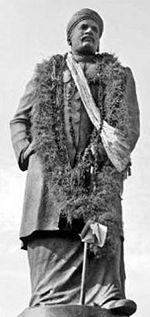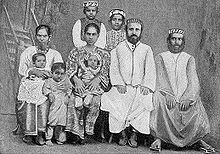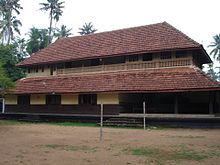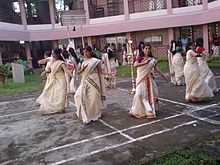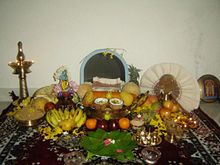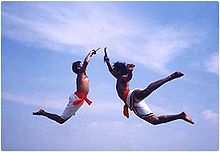- Malayali
-
മലയാളി
Malayali
Plural: Malayalikal







Notable List of Malayalees: Adi Shankara • Shashi Tharoor • Arundhati Roy • Adoor Gopalakrishnan • Sreesanth • • Narayana Guru • Raja Ravi Varma • K. R. Narayanan
Total population 35,757,100 (1997)[1] Regions with significant populations  India
India33,066,392  United Arab Emirates
United Arab Emirates773,624 [2]  Saudi Arabia
Saudi Arabia447,440 [2]  Kuwait
Kuwait134,728 [2]  Oman
Oman134,019 [2]  United States
United States105,655 [2]  United Kingdom
United Kingdom100,737 [2]  Qatar
Qatar94,310 [2]  Bahrain
Bahrain58,146 [2]  Canada
Canada12,346 [2]  Malaysia
Malaysia11,936 [2]  Australia
Australia10,793 [3]  Singapore
Singapore7,800 [2]  Pakistan
Pakistan6,000 [4]  Israel
Israel Germany
Germany Thailand
Thailand South Africa
South Africa Botswana
Botswana Maldives
MaldivesLanguages Malayalam (മലയാളം)
Religion Related ethnic groups Dravidian people, Brahui people, Kannadiga, Tamil people, Telugu people, Tuluva
Malayali (also spelled Malayalee; Malayalam: മലയാളി, Malayāḷi ?; plural: Malayalikal) is the term used to refer to the native speakers of Malayalam, originating from the Indian state of Kerala. The Malayali identity is primarily linguistic, although in recent times the definition has been broadened to include emigrants of Malayali descent who partly maintain Malayali cultural traditions, even if they do not regularly speak the language. While the origins of the Malayali people are in the state of Kerala, significant populations also exist in other parts of India, the Middle East, Europe and North America. According to the Indian census of 2001, there were 30,803,747 speakers of Malayalam in Kerala,[5] making up 96.7% of the total population of that state. Hence the word Keralite is often used in the same context, though a proper definition is ambiguous.
Contents
Etymology
Malayalam, the Malayalis' native language, has its origin from the words mala meaning mountain and alam meaning land (Tamil/Malayalam) or locality (which lies along side the mountain).[6] Hence 'Malayali' means people from the mountains who lived beyond the Western Ghats, and Malayalam the language that was spoken there.
Geographic distribution and population
According to the Indian census of 2001, there were 30,803,747 speakers of Malayalam in Kerala, making up 93.2% of the total number of Malayalam speakers in India, and 96.7% of the total population of the state. There were a further 701,673 (2.1% of the total number) in Karnataka, 557,705 (1.7%) in Tamil Nadu, and 406,358 (1.2%) in Maharashtra. The number of Malayalam speakers in Lakshadweep is 51,100, which is only 0.15% of the total number, but is as much as about 84% of the population of Lakshadweep. In all, Malayalis made up 3.22% of the total Indian population in 2001. Of the total 33,066,392 Malayalam speakers in India in 2001, 33,015,420 spoke the standard dialects, 19,643 spoke the Yerava dialect and 31,329 spoke non-standard regional variations like Eranadan.[5] As per the 1991 census data, 28.85% of all Malayalam speakers in India spoke another second language and 19.64% of the total knew 3 or more languages.
Large numbers of Malayalis have settled in Delhi, Bangalore, Hyderabad, Mumbai (Bombay), Pune and Chennai (Madras). A large number of Malayalis have also emigrated to the Middle East, the United States, and Europe. There were 179,860 speakers of Malayalam in the United States, according to the 2000 census, with the highest concentrations in Bergen County, New Jersey and Rockland County, New York. There were 7,093 Malayalam speakers in Australia in 2006.[3] The 2001 Canadian census reported 7,070 people who listed Malayalam as their mother tongue. The 2006 New Zealand census reported 2,139 speakers.[7] 134 Malayalam speaking households were reported in 1956 in Fiji. There is also a considerable Malayali population in the Persian Gulf regions, especially in Dubai.
Communities
Historically, religion and caste played a major role in community, with individuals associating and marrying within their religion or caste. Hence, Malayali communities can be differentiated along historical religious lines.
Hindu
Ezhava
The Ezhavas are the largest Hindu community in Kerala. Ezhavas are also found amongst the Malayali diaspora around the world. Ezhavas are today a social group sharing a common history from the pre-social reform era. With a population of 7.3 million Ezhavas are the largest Hindu community in Kerala.
Samanta Kshatriya
Main article: Samanta KshatriyaThe Samanta Kshatriyas (also known as Malayala Kshatriya) who use the surname Varma or Raja, are a group of people who belonged to the Chandravanshi Kshatriya division of the Hindu caste system among Malayalees and their residences were traditionally called Kovilakams or Kottaram or Swaroopams. They themselves belong to a subgroup of Nairs and they form the highest ranking division among Nairs. In traditional texts such as the Keralolpathi they are referred to as "Samantha Kshatriyas".
Nambudiri
The Nambudiri Brahmins are the indigenous Brahmins of Kerala, who are considered the most orthodox Brahmins in India.[8] They perform rituals in temples of Kerala based on Tantra Vidhi, a complex and ancient branch of Tantric traditions found only in Kerala, and some Mahakshetras ("Great Temples") around India (which have a Nambudiri acting as the Head Priest). Namboothiris follow the conservative and ritualistic Śrauta traditions and the ancient Purva Mimamsa, unlike the majority of other Brahmins in India who follow the Vedanta.
Nair
Nairs (sometimes spelled Nayar) are a Hindu upper caste belonging to Nagavanshi division of the Hindu caste system. The Nairs were a martial nobility[9][10][11][12] and figure prominently in the history of Kerala. The Nairs form the second largest Hindu community in Kerala.
Ambalavasi
Ambalavasi is the name of a Kerala community (not to be confused with caste) composed of a number of Hindu castes such as Pushpakas (Unni, Nambeesan, etc.), Chakyars, Moothaths, Ilayaths, Kurukkals, Warriers, Marars, Nambiars, Pisharody, etc. Traditionally, they perform temple related jobs and art forms.
Pulaya
The Pulayas, also known as Pulayar are one of the main social groups found in the Kerala society, who were traditionally engaged in various agriculture-related occupations. Ayyankali (1863–1914), one among the great social reformers of India, who was praised by Mahatma Gandhi when he visited Venganoor, was born to a Malayali Pulaya family.
Muslim
Malayali Muslims are members of a Malayalam-speaking Islamic community spread across Kerala, Lakshadweep, Kodagu and across Malayali Diaspora around the world. In North Kerala they are known as Mappilas or Moplahs. The word mappila is derived from the old (pure) Malayalam words Amma and pilla meaning Child Mother. The Mappilas are believed to be the earliest known Indian Muslim community, having existed since the 8th century CE, when Arab merchants who had long been trading with the Chera kingdom settled in Kerala. The Muslims in Kerala cannot be easily distinguished in the community as they still retain their Malayali features.[citation needed] They follow the preachings of monotheism by Muhammad in Arabia, especially the UAE and other Gulf countries . They propagated their Islamic faith along the Malabar Coast. Most Mappila Muslims follow the Shafi'i school of Muslim Jurisprudence (in contrast to the Hanafi school followed by most South Asian Muslims). A good amount of mappila's find their income from gulf region. In north malabar, from malappuram to kasargod, at least one of 3 Muslim house have foreign income.
Christian
Christians form the third largest group in Kerala. Over the centuries, they have blended well with the changing socio-cultural environment of the region, becoming uniquely Indian and Christian.
According to beliefs, Christianity in India dates to Thomas the Apostle’s conversion of local population in Kerala during the 1st century CE.[13] The 3rd and 4th centuries saw an influx of Christians from the Middle East. Knanaya communities arrived during this time. Distance kept the community of St Thomas Christians separate from other Christian communities until about the 8th century, when they started receiving bishops and support from the Chaldean Church. The arrival of Europeans in the 15th century and discontent with Portuguese interference in religious matters fomented schism into Catholic and Orthodox communities. Further schism, rearrangements, and missionary activity led to the formation of the other Indian Churches. Latin Rite Christians were converted by the Portuguese in the 16th and 19th centuries mainly from communities where fishing was the traditional occupation. Anglo-Indian Christian communities formed around this time as Europeans and local Malayalis intermarried. Protestantism arrived a few centuries later with missionary activity during British rule. The community today can broadly divided into Catholic, Orthodox, Pentecost and Protestant groups. It is important to note that despite being a heterogeneous group, Malayali Christians find unity in a common history and faith.
Jewish
Cochin Jews, also called Malabar Jews (Malabar Yehudan) are the ancient Jews and their descendants of the erstwhile state of Kingdom of Cochin which includes the present day port city of Kochi.[14] They traditionally spoke Judeo-Malayalam, a form of the Malayalam tongue, native to the state of Kerala. The Jews of Cochin did not adhere to the Talmudic prohibition, followed by other Orthodox Jews, against public singing by women, and therefore have a rich tradition of Jewish prayers and narrative songs performed by women in Judeo-Malayalam.
Their population has been greatly reduced from historical numbers, as many have emigrated to Israel to settle in the Negev. Part of the decline in Kerala's Jewish population can also be attributed to conversion.[15] Many of the Jews that converted during the time of Saint Thomas became Kerala's Nasrani or Saint Thomas Christians.[15]
Unclassified
Main article: Atheism in KeralaWith the growth in intermarriage between Malayali communities and also with other groups, especially outside Kerala, many people who identify themselves with Kerala or with Malayali culture can not readily be labeled as members of one of the historic castes or communities listed above. Also, although a number of these groups were historically affiliated to one or other religion or sect, many of their modern members may be agnostic or atheist, or identify more strongly with some other religious or non-religious ideology. Nevertheless, Malayalis have been a open-minded people who are accepting of various groups irrespective of caste and class in their community.
Culture
Malayali cultural genesis can be traced to their membership (around the 3rd century CE) in a well defined historical region known as Tamilakam, encompassing the Chera, Chola, and Pandya kingdoms and southern coastal Karnataka. Later upon the arrival of other ethnic groups such as Namboothiris, Nairs, etc. the distinct culture took shape. This was later elaborated upon by centuries of contact with foreign cultures such as Syrian, Judeo, Arabian, Portuguese, English communities which have left their mark.[16] These foreign communities often settled in Kerala and assimilated with the local population resulting in different ethnic groups such as the Cochin Jews, Mappilas, Syrian Malabar Nasranis, and Anglo Indian.
Language and Literature
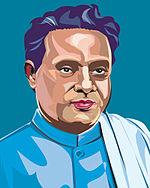 Mahakavi Kumaran Asan was one of the Triumvirate poets of modern Malayalam. Shown here is a portrait of Asan.
Mahakavi Kumaran Asan was one of the Triumvirate poets of modern Malayalam. Shown here is a portrait of Asan.
Malayalam is the language spoken by the Malayalis. Malayalam is derived from Middle Tamil in the 6th century, of which Modern Tamil was also derived.[17] An alternative theory proposes a split in more ancient times.[17] For cultural purposes Malayalam and Sanskrit formed a language known as Manipravalam, where both languages were used in an alternating style. Malayalam is the only among the major Dravidian languages without diglossia. This means, that the Malayalam which is spoken does not differ from the written variant. Malayalam is written using the Malayalam script.
Malayalam literature is ancient in origin. The oldest literature works in Malayalam, distinct from the Tamil tradition, is dated between 9th century and 11th century.[17] Malayalam literature includes the 14th century Niranam poets (Madhava Panikkar, Sankara Panikkar and Rama Panikkar), whose works mark the dawn of both modern Malayalam language and indigenous Keralite poetry. The Triumvirate of poets (Kavithrayam: Kumaran Asan, Vallathol Narayana Menon and Ulloor S. Parameswara Iyer)[18] are recognized for moving Keralite poetry away from archaic sophistry and metaphysics and towards a more lyrical mode.In the second half of the 20th century, Jnanpith awardees like G. Sankara Kurup, S. K. Pottekkatt, Thakazhi Sivasankara Pillai and M. T. Vasudevan Nair have made valuable contributions to the Malayalam literature. Later, such Keralite writers as O. V. Vijayan, Kamaladas, M. Mukundan, and Booker Prize winner Arundhati Roy, whose 1996 semi-autobiographical bestseller[19] The God of Small Things is set in the Kottayam town of Ayemenem, have gained international recognition.[20][21]
Tharavadu
Tharavadu is a system of joint family practised by Malayalis, especially castes like Nambudiris, Nairs, and Ezhavas. Each Tharavadu has a unique name. The Tharavadu was administered by the Karanavan, the oldest male member of the family.[22] He would be the eldest maternal uncle of the family as well. The members of the Tharavadu consisted of mother, daughters, sons, sisters and brothers. The fathers and husbands had very minimal role to play in the affairs of the Tharavadu. It was a true matrilineal affair. The Karanavar took all major decisions. He was usually autocratic. However, the consent of the eldest female member of the family was taken before implementing the decisions. This eldest female member would be his maternal grandmother, own mother, mother's sister, his own sister or a sister through his maternal lineage. Since the lineage was through the female members, the birth of a daughter was always welcomed. Each Tharavadu also has a Para Devatha (clan deity) revered by those in the particular Tharavadu. Temples were built to honor these deities.
Kerala's society is less patriarchical than the rest of the Majority World.[23][24] Certain Hindu communities such as the Nairs, some Ezhava families in Travancore and Cochin, Ezhavas in north Kerala and Muslims around Kannur used to follow a traditional matrilineal system known as marumakkathayam which has in the recent years (post Indian independence) ceased to exist. Christians, Muslims, and some Hindu castes such as the Namboothiris and some Ezhavas follow makkathayam, a patrilineal system.[25] Kerala's gender relations are among the most equitable in India and the Majority World.[26][27]
Architecture
Main article: Architecture of KeralaKerala, the native land of Malayalis has a tropical climate with excessive rains and intensive solar radiation.[28] The architecture of this region has evolved to meet these climatic conditions by having the form of buildings with low walls, sloping roof and projecting caves.[28] The setting of the building in the open garden plot was again necessitated by the requirement of wind for giving comfort in the humid climate.[28] Timber is the prime structural material abundantly available in many varieties in Kerala. Perhaps the skillful choice of timber, accurate joinery, artful assembly and delicate carving of wood work for columns, walls and roofs frames are the unique characteristics of Malayali architecture.[28] From the limitations of the materials, a mixed mode of construction was evolved in Malayali architecture. The stone work was restricted to the plinth even in important buildings such as temples. Laterite was used for walls. The roof structure in timber was covered with palm leaf thatching for most buildings and rarely with tiles for palaces or temples.[28] The Kerala murals are paintings with vegetable dyes on wet walls in subdued shades of brown. The indigenous adoption of the available raw materials and their transformation as enduring media for architectural expression thus became the dominant feature of the Malayali style of architecture.[28]
Nalukettu
Nalukettu is a quadrangular building constructed after following the Tachu Sastra(Science of Carpentry). In past, Nalukettu was the house in which Malayalis lived.[29] It was a typical house which was flanked by out-houses and utility structures.The large house-Nalukettu is constructed within a large compound.It was called Nalukettu because it consisted of four wings around a central courtyard called Nadumuttom.[29] The house has a quadrangle in the center. The quadrangle is in every way the center of life in the house and very useful for the performance of rituals.The layout of these homes was simple, and catered to the dwelling of a large number of people, usually part of a tharavadu. Ettukettu (eight halled with two central courtyards) or Pathinarukettu (sixteen halled with four central courtyards) are the more elaborate forms of the same architecture. An example of a Nalukettu structure is Mattancherry Palace.[29]
Performing Arts and Music
Malayalis use two words to denote dance, which is attom and thullal.[30] The art forms of Malayalis are classified into three types.They are (i)Religious like Theyyam, Bhagavatipattu etc., (ii)Semi religious like Sanghakali, Krishnanattom etc., and (iii)Secular like Kathakali, Mohiniaattam, Thullal etc.[30]Kathakali and Mohiniaattam are the two classical dance forms from Kerala.[31] Kathakali is actually a dance-drama.Mohiniaattam is a very sensual and graceful dance form that is performed both solo and in a group by women.[31]Kutiyattam is a traditional performing art form from Kerala, which is recognised by UNESCO and given the status Masterpieces of Oral and Intangible Heritage of Humanity.[32]Ottamthullal is another performing art, which is also known as the poor man's Kathakali, which was created by the poet Kunchan Nambiar as an alternative to Chakiarkooth (another performing art),which was open only for higher castes to see.[33]Theyyam is a ritualistic art form of Malayalis, which is thought to predate hinduism and to have developed from folk dances performed in conjunction with harvest celebrations.Theyyam is performed as an offering to gods so as to get rid of poverty and illness.[34] Velakali is another ritualistic art form, mainly performed at temples in the festival time.Kolkali is a folk art in which dance performers move in a circle, striking small sticks and keeping rhythm with special steps. Many ancient Malayali family houses in Kerala have special snake shrines called Kavu. Sarpam Thullal is usually performed in the courtyard of houses having snake shrines. This is a votive offering for family wealth and happiness.
Performing arts in Kerala is not limited to a single religion of the Malayali society. The Malayalam speaking Muslim community of Kerala, known as Mappila and the Christian community has their own unique performing art forms.Duff Muttu, also known as Dubh Muttu/Aravanamuttu[35] is a performing art form prevalent among the Muslim community.It is a group performance,staged as a social event during festivals and nuptial ceremonies.[35] Oppana is a popular form of social entertainment among the Muslim community.It is a form accompanied by clapping of hands, in which both men and women participate.[36] Margamkali is a performing art which is popular among the Syro-Malabar and Syro-Malankara Christians.It combines both devotion and entertainment, and was performed by women in groups.[37] Since 1980's women also have found groups.The dancers themselves sing the margamkali songs in unison call and response form.[37]Parichamuttikali is another performing art which is popular among all sections of Christian community.This is an artistic adaptation of the martial art of Kerala, Kalaripayattu.[37] Chavittu nadakom is a theatrical art form observed mainly by Kerala Latin Christians, dating back to second half of 16th century.[37]
However, many of these native art forms largely play to tourists or at youth festivals, and are not as popular among ordinary Keralites. Thus, more contemporary forms – including those heavily based on the use of often risqué and politically incorrect mimicry and parody – have gained considerable mass appeal in recent years. Indeed, contemporary artists often use such modes to mock socioeconomic elites. In recent decades, Malayalam cinema, yet another mode of widely popular artistic expression, have provided a distinct and indigenous Keralite alternative to both Bollywood and Hollywood.
Music formed a major part of early Malayalam literature, which is believed to have started developing by 9th century CE.[38] The significance of music in the culture of Kerala can be established just by the fact that in Malayalam language, musical poetry was developed long before prose.Kerala is musically known for Sopanam. Sopanam is religious in nature, and developed through singing invocatory songs at the Kalam of Kali, and later inside temples. Sopanam came to prominence in the wake of the increasing popularity of Jayadeva's Gita Govinda or Ashtapadis. Sopana sangeetham (music), as the very name suggests, is sung by the side of the holy steps (sopanam) leading to the sanctum sanctorum of a shrine. It is sung, typically employing plain notes, to the accompaniment of the small, hourglass-shaped ethnic drum called idakka, besides the chengila or the handy metallic gong to sound the beats. Sopanam is traditionally sung by men of the Marar and Pothuval community, who are Ambalavasi (semi-Brahmin) castes engaged to do it as their hereditary profession. Kerala is also home of Carnatic music. Legends like Swati Tirunal, Shadkala Govinda Maarar,Sangitha Vidwan Gopala Pillai Bhagavathar, Chertala Gopalan Nair, M. D. Ramanathan, T. V. Gopalakrishnan, M.S.Gopalakrishnan,K.J.Yesudas,L.Subramaniam and T. N. Krishnan are Malayali musicians.Also among the younger generations with wide acclaim and promise is Child Prodigy Violinist L.Athira Krishna etc., who are looked upon as Maestros of tomorrow.[39] Kerala also has a significant presence of Hindustani music as well.[40] The king of Travancore, Swathi Thirunal patronaged and contributed much to the Hindustani Music. The pulluvar of Kerala are closely connected to the serpent worship. One group among these people consider the snake gods as their presiding deity and perform certain sacrifices and sing songs. This is called Pulluvan Pattu.The song conducted by the pulluvar in serpent temples and snake groves is called Sarppapaattu, Naagam Paattu, Sarpam Thullal, Sarppolsavam, Paambum Thullal or Paambum Kalam. Mappila Paattukal or Mappila Songs are folklore Muslim devotional songs in the Malayalam language. Mappila songs are composed in colloquial Malayalam and are sung in a distinctive tune. They are composed in a mixture of Malayalam and Arabic.
Film music, which refers to playback singing in the context of Indian music, forms the most important canon of popular music in India. Film music of Kerala in particular is the most popular form of music in the state.[40] Before Malayalam cinema and Malayalam film music developed, the Keralites eagerly followed Tamil and Hindi film songs and that habit has stayed with them till now.
Vallam Kali
Vallam Kali, is the race of country made boats. It is mainly conducted during the season of the harvest festival Onam in Autumn. Vallam Kali include races of many kinds of traditional boats of Kerala. The race of Chundan Vallam (snake boat) is the major item. Hence Vallam Kali is also known in English as Snake Boat Race and a major tourist attraction. Other types of boats which do participate in various events in the race are Churulan Vallam, Iruttukuthy Vallam, Odi Vallam, Veppu Vallam (Vaipu Vallam), Vadakkanody Vallam, and Kochu Vallam. Nehru Trophy Boat Race is one the famous Vallam Kali held in Punnamada Lake in Alappuzha district of Kerala. Champakulam Moolam Boat Race is the oldest and most popular Vallam Kali in Kerala. The race is held on river Pamba on the moolam day (according to the Malayalam Era) of the Malayalam month Midhunam, the day of the installation of the deity at the Ambalappuzha Sree Krishna Temple. The Aranmula Boat Race takes place at Aranmula, near a temple dedicated to Lord Krishna and Arjuna. Thousands of people gather on the banks of the river Pamba to watch the snake boat races. Nearly 30 snake boats or chundan vallams participate in the festival. Payippad Jalotsavam is a three day water festival. Its conducted in Payippad Lake which is 35 km from Alappuzha district of Kerala state. There is a close relation between this Payippad boat race and Subramanya Swamy Temple in Haripad. Indira Gandhi Boat Race is a boat race festival celebrated in the last week of December in the backwaters of Kochi, a city in Kerala. This boat race is one of the most popular Vallam Kali in Kerala. This festival is conducted to promote Kerala tourism.
Festivals
Malayalis celebrate a variety of festivals. Other than the two given below Malayalis also celebrate Christmas and Bakrid.
Onam
Onam is an annual harvest festival, celebrated mainly in Kerala, although celebrations also occur among the diaspora. It is the foremost festival among the cultural repertoire of Malayalis, and falls during the month of Chingam (August–September as per the Gregorian calendar), the first month of the Malayalam calendar and lasts for ten days from the Star Atham in Chingam. Though it is essentially a harvest festival of Malayalis, mythologically it is linked to Malayali-Hindu folktales. Like many other religious festivals in India, Onam is celebrated by people across all castes and faiths. Onam has been part of Malayali psyche for centuries. There are records of Onam being celebrated during the Sangam Age. The earliest record of Onam is found during time of Kulasekhara Perumals around AD 800, soon after the Kalabhra Interregnum of Kerala History. Until the eighth century the political history is mostly unknown and is usually known as the Kalabhra Interregnum. Kalabhras were supposed to have been ruling Kerala until at least the sixth century. Kalabhras probably refers to Keralaputras. They are believed to be people of Mayavi.
Onam has two specific significance. First it is the communal memory and celebration of past history as ennunciated in the Mahabali Legend. A story of how paradise was lost. Second it is the celebration of the harvest tied with the memory of the golden age of prosperity. It is believed that during those days the whole of Chingam was celebrated as Onam season. After the rain drenched month of Karkidakam with its privations, Chingam is a welcome month for people in the state of Kerala. The festival is the harbinger of spring – signalling the start of the harvest season. Onam epitomizes the newfound vigour and enthusiasm of the season, and is celebrated with traditional fervour with visit to temples, family get-togethers, gifting each other clothes called Onakkodi and lots of merry making. Thiruvathira is in the malayalam month Dhanu (Dec–Jan). it is considering as the bithday of Lord Shiva.
Vishu
Vishu is a festival celebrated by Malayalis around the first day in the Malayalam month of Medam (April – May). This occasion signifies the Sun's transit to the zodiac Mesha (Mesha Raasi) as per Indian astrological calculations. Vishu is also considered as the Malayalam New Year day and thus the importance of this day to all Malayalis regardless of their religion or sect. Similarly the day is celebrated in almost all places in India by the Hindus albeit by different names. In Assam this day is called Bihu, in Punjab Baisakhi and in Tamil Nadu Puthandu. The word "Vishu" in Sanskrit means "equal". Therefore Vishu is more probably denoting one of the equinox days.
The festival is marked with offerings to the divine called Vishukkani. The offerings consist of a ritual arrangement in the puja room of auspicious articles like raw rice, fresh linen, golden cucumber, betel leaves, arecanut, metal mirror, the yellow flowers konna (Cassia fistula), and a holy text and coins, in a bell metal vessel called uruli. A lighted bell metal lamp called nilavilakku is also placed alongside. This arrangement is completed the previous night. On the day of Vishu, the custom is to wake up at dawn and go to the puja room with the eyes closed so that the Vishukkani is the first thing one sees. Since the occasion marks the beginning of Malayalam New Year, it is also considered auspicious to read verses from Hindu Holy book Ramayanam after seeing the Vishukkani. It is also believed by some that the page of the Ramayanam to which you open up will have a bearing on your life in the coming year. Devotees also throng the well-known temples like Sabarimala Ayyappan Teample, Guruvayur Sree Krishna temple to have a "Vishukkani Kazhcha" on the early hours of "Vishu" day.
Cuisine
The cuisine of Malayalis are linked in all its richness to the history, geography and culture of the land. Spices form an important ingredient in almost all curries. Malayali cuisine is not homogeneous and regional variations are visible throughout. Kerala is known for its traditional sadhyas, a vegetarian meal served with boiled rice and a host of side-dishes. The sadhya is complemented by payasam, a sweet milk dessert native to Kerala. The sadhya is, as per custom, served on a banana leaf. Traditional dishes include sambar, aviyal, kaalan, theeyal, thoran, injipully, pulisherry, appam, kappa (tapioca), puttu (steamed rice powder), and puzhukku. Coconut is an essential ingredient in most of the food items and is liberally used.
Puttu is a culinary specialty in Kerala. It is a steamed rice cake which is a favourite breakfast of most Malayalis. It is served with either brown chickpeas cooked in a spicy gravy, papadams and boiled small green lentils, or tiny ripe yellow Kerala plantains. In the highlands there is also a variety of puttu served with paani (the boiled-down syrup from sweet palm toddy) and sweet boiled bananas. to steam the puttu, there is a special utensil called "Puttu Kutti". It consists of two sections. The lower bulkier portion is where the water for steaming is stored. The upper detachable leaner portion which is separated from lower portion with peforated lids so as to allow the steam to pass through and bake the rice powder which has been filled. The upper portion of the leaner section is covered with a peforated cup shaped lid once it is filled with rice powder.
Appam is a pancake made of fermented batter. The batter is made of rice flour and fermented using either yeast or toddy, the local spirit. It is fried using a special frying pan called appa-chatti and is served with egg curry, chicken curry, mutton stew, vegetable curry and chick pea curry.
Martial arts
See also: KalaripayattuMalayalis have their own lethal form of martial arts called Kalaripayattu. This type of martial arts was used as defensive mechanism against intruders . In ancient times, disputes between (naaduvazhis or Vazhunors)nobles were also settled by the outcome of a Kalaripayattu tournament. This ancient martial art is claimed as the mother of all martial arts – even the Chinese Shaolin chuan from the famous Shaolin temple traces its ancestry to Bodhidharma, an Indian Buddhist monk who was a Kalaripayattu expert.[41][42][43] The word "kalari" can be traced to ancient Sangam literature.[44] The martial tradition of Kalaripayattu is also dated to ancient Dravidian traditions.[45] Phillip Zarrilli, a professor at the University of Exeter and one of the few Western authorities on kalaripayattu, estimates that kalarippayattu dates back to at least the 12th century CE.[46] The historian Elamkulam Kunjan Pillai attributes the birth of Kalaripayattu to an extended period of warfare between the Cheras and the Cholas in the 11th century CE.[46] What eventually crystallized into this style is thought to have been a product of existing South Indian styles of combat, combined with techniques brought by migration from the north along the western coast.[46] What eventually crystallized as kalarippayattu combined indigenous Dravidian techniques with the martial practices and ethos brought by brahman migrations from Saurastra and Konkan down the west Indian coast into Karnataka and eventually Kerala. Discovery channel notes that Kalaripayattu may be one of the oldest martial arts in existence.[41] The oldest western reference to Kalaripayattu is a 16th century travelogue of Duarte Barbosa, a Portuguese explorer. The Southern style, which places more emphasis on open hand combat was mostly practiced in the southern regions of Kerala.[47]
Keralites
List of famous Keralites
See also
- Non Resident Keralites Affairs
- World Malayalee Council
References
- ^ Ethnologue report for Malayalam
- ^ a b c d e f g h i j k Zachariah, K. C. & Rajan, S. Irudaya (2008), Kerala Migration Survey 2007 (PDF), Department of Non-resident Keralite Affairs, Government of Kerala, p. 48. This is the number of emigrants from Kerala, which is closely related to but different from the actual number of Malayalis.
- ^ a b [1]
- ^ Where Malayalees once held sway: DNA India
- ^ a b [2], censusindia.net
- ^ "kerala.gov.in". http://www.kerala.gov.in/.-go to the website and click the link – language & literature to retrieve the information
- ^ Statistics New Zealand:Language spoken (total responses) for the 1996–2006 censuses (Table 16), stats.govt.nz
- ^ [3], encyclopedia.com
- ^ Neither Newton nor Leibniz, canisius.edu
- ^ From Vedic Martial Arts to Aikido, veda.harekrsna.cz
- ^ A travel feature on the ancient Kerala art of Kalaripayattu, rediff.com
- ^ Kalaripayattu, the traditional martial art, enskalari.org.in
- ^ A.E. Medlycott, India and The Apostle Thomas, pp.1–71, 213–97; M.R. James, Apocryphal New Testament, pp.364–436; Eusebius, History, chapter 4:30; J.N. Farquhar, The Apostle Thomas in North India, chapter 4:30; V.A. Smith, Early History of India, p.235; L.W. Brown, The Indian Christians of St. Thomas, p.49-59
- ^ Katz 2000; Koder 1973; Menachery 1998; Thomas Puthiakunnel 1973; Weil 1982; Menachery 1998.
- ^ a b Weil S. 1982; Jessay P.M. 1986; Menachery 1973; Menachery 1998.
- ^ Bhagyalekshmy 2004, pp. 6–7.
- ^ a b c Malayalam, R. E. Asher, T. C. Kumari, Routledge, ISBN 0-415-02242-8, 1997
- ^ "Trios of modern Malayalam literature". http://books.google.co.in/books?id=vfSPI2irzUgC&pg=PA185&dq=Vallathol#v=onepage&q=Vallathol&f=false.
- ^ Cooper KJ (20 October 1997). "For India, No Small Thing; Native Daughter Arundhati Roy Wins Coveted Booker Prize". Washington Post. http://pqasb.pqarchiver.com/washingtonpost/access/19563051.html?dids=19563051:19563051&FMT=ABS&FMTS=ABS:FT&date=OCT+20%2C+1997&author=Kenneth+J.+Cooper&pub=The+Washington+Post&desc=For+India%2C+No+Small+Thing%3B+Native+Daughter+Arundhati+Roy+Wins+Coveted+Booker+Prize&pqatl=google. Retrieved 28 December 2008.
- ^ Lyall, Sarah (15 October 1997). "Indian's First Novel Wins Booker Prize in Britain". New York Times. http://query.nytimes.com/gst/fullpage.html?res=9A01E6DD173FF936A25753C1A961958260. Retrieved 11 November 2007.
- ^ "Winds, Rivers & Rain". Salon. September 1997. http://www.salon.com/sept97/00roy.html. Retrieved 11 November 2007.
- ^ "Tharavadu system". http://books.google.co.in/books?id=rMRw0gTZSJwC&pg=PA84&dq=Malayali+tharavadu+system#v=onepage&q=&f=false.
- ^ McKibben 2006.
- ^ Lindberg 2004, pp. 18–19.
- ^ Government of Kerala 2002b.
- ^ Government of Kerala 2004r, p. 366.
- ^ Lindberg 2004, p. 1.
- ^ a b c d e f "Kerala architecture". http://www.keralahistory.ac.in/keralaarchitecture.htm.
- ^ a b c "Nalukettu". http://www.malayalamresourcecentre.org/Mrc/culture/cultureofkerala/kerala.html.-Malayalam Resource Centre
- ^ a b "Kerala dance forms". http://books.google.co.in/books?id=waWQ8mAUrC8C&pg=PA139&dq=Kerala+dance#v=onepage&q=Kerala%20dance&f=false.
- ^ a b "Classical dance forms of India". http://dances.indobase.com/classical-dances/index.html.
- ^ "Koodiyattam". http://books.google.co.in/books?id=lDhuAAAAMAAJ&q=Koodiyattam+UNESCO&dq=Koodiyattam+UNESCO.
- ^ "Ottamthullal". http://books.google.co.in/books?id=L8bExoV6GL8C&pg=PA70&dq=Ottamthullal#v=onepage&q=Ottamthullal&f=false.
- ^ "Theyyam". http://books.google.co.in/books?id=Fk8FQa2ZSFQC&pg=PA928&dq=Theyyam#v=onepage&q=Theyyam&f=false.
- ^ a b "Duffmuttu". http://books.google.co.in/books?id=ZYfRBcLdTNYC&pg=PA8&dq=duffmuttu#v=onepage&q=duffmuttu&f=false.
- ^ "Oppana". http://books.google.co.in/books?id=zh6z0nuIjAgC&pg=PA149&dq=Oppana#v=onepage&q=Oppana&f=false.
- ^ a b c d "Christian art foms". http://books.google.co.in/books?id=ZOlNv8MAXIEC&pg=RA2-PA945&dq=Margamkali#v=onepage&q=Margamkali&f=false.
- ^ Sreedhara Menon, A.. Kerala Charithram. Kottayam, Kerala: D.C. Books. p. 494.
- ^ Rolf, Killius (2006). Ritual Music and Hindu Rituals of Kerala. New Delhi: BR Rhythms. ISBN 81-88827-07-X.
- ^ a b "Music". Keral.com. Archived from the original on 2 August 2008. http://web.archive.org/web/20080802081714/http://www.keral.com/movies/music.htm. Retrieved 2 January 2009.
- ^ a b [4]
- ^ Bodhidharma bought Kalari to China [5]
- ^ Bodhidharma and Kalari [6]
- ^ Suresh, P. R. (2005). Kalari Payatte – The martial art of Kerala.
- ^ Subaltern Sports: Politics and Sports in South Asia By James H. Mills. Published 2005, Anthem Press. Subject: Archaeology /Anthropology. ISBN 1-84331-167-4
- ^ a b c Zarrilli, Phillip B. A South Indian Martial Art and the Yoga and Ayurvedic Paradigms. University of Wisconsin–Madison.
- ^ Phillip B. Zarrilli, When the Body Becomes All Eyes
Kerala topics History Sangam period · Edakkal Caves · Chera · Kerala school · Battle of Kulachal · Anglo-Mysore Wars · Vaikom Satyagraham · Perumpadapu Swaroopam · Malabar Migration ·Government
PoliticsAgencies · Chief Ministers · Governors · Legislative Assembly · Panchayat elections · Left Democratic Front · United Democratic Front · PoliticiansGeography Agasthyamala Biosphere Reserve · Annamalai Hills · Backwaters · Districts · Eravikulam National Park · Flora and fauna · Malabar Coast · Marayoor · Nelliampathi Mountains · Nilgiri Biosphere Reserve · Nilgiri Hills · Palakkad Gap · Protected areas · Vembanad LakeDemographics
Economy
ReligionMalayalis · Namboothiris · Ambalavasis · Samanthas · Nairs · Syrian Malabar Nasranis · Kerala Iyers · Ezhavas · Cochin Jews · Pulayar · Dravidians · Mappilas · Paradesi Jews · Adivasis · Sephardic Jews in Kerala · Scheduled Tribes · Kerala model · Tourism · Education (colleges and universities)Culture Dance / Drama / CinemaKathakali · Kolkali · Koodiyattam · Mohiniyattam · Margamkali · Ottamthullal · Theyyam · Cinema of KeralaFestivalsLanguagesChenda (Thayambaka) · Duff muttu · Mappila paattukal · Oppana · Panchari melam · Panchavadyam · SopanamOrganizations/AgenciesTourism Alappuzha · Athirappilly Falls · Beaches in Kerala · Kerala Backwaters · Kovalam · Munnar · Tourism in Thiruvananthapuram · Vallamkali · Wayanad · Bekal ·
Kerala on Wikinews
News
Kerala on Wikiquote
Quotes
Kerala on Commons
Images
Kerala on Wikisource
TextsExternal links
} Categories:- Kerala society
- Malayali people
- Dravidian peoples
Wikimedia Foundation. 2010.


